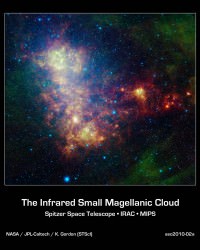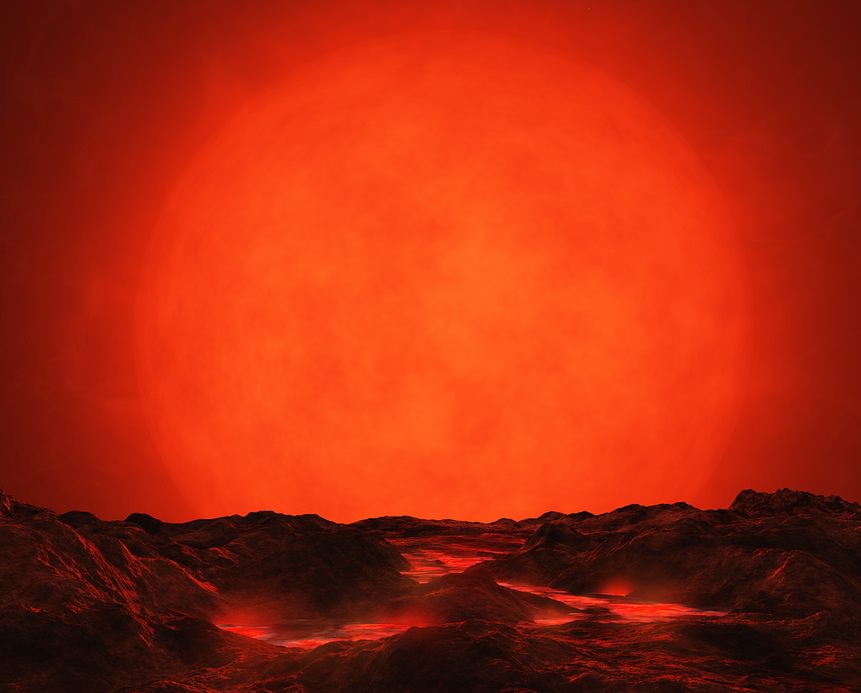One has never been spotted for sure in the wild jungle of strange stellar objects out there, but astronomers now think they have finally found a theoretical cosmic curiosity: a Thorne-Zytkow Object, or TZO, hiding in the neighboring Small Magellanic Cloud. With the outward appearance of garden-variety red supergiants, TZOs are actually two stars in one: a binary pair where a super-dense neutron star has been absorbed into its less dense supergiant parter, and from within it operates its exotic elemental forge.
First theorized in 1975 by physicist Kip Thorne and astronomer Anna Zytkow, TZOs have proven notoriously difficult to find in real life because of their similarity to red supergiants, like the well-known Betelgeuse at the shoulder of Orion. It’s only through detailed spectroscopy that the particular chemical signatures of a TZO can be identified.

Observations of the red supergiant HV 2112 in the Small Magellanic Cloud*, a dwarf galaxy located a mere 200,000 light-years away, have revealed these signatures — unusually high concentrations of heavy elements like molybdenum, rubidium, and lithium.
While it’s true that these elements are created inside stars — we are all star-stuff, like Carl Sagan said — they aren’t found in quantity within the atmospheres of lone supergiants. Only by absorbing a much hotter star — such as a neutron star left over from the explosive death of a more massive partner — is the production of such elements presumed to be possible.
“Studying these objects is exciting because it represents a completely new model of how stellar interiors can work,”said Emily Levesque, team leader from the University of Colorado Boulder and lead author on the paper. “In these interiors we also have a new way of producing heavy elements in our universe.”
Definitive detection of a TZO would provide direct evidence for a completely new model of stellar interiors, as well as confirm a theoretically predicted fate for massive star binary systems and the existence of nucleosynthesis environments that offer a new channel for heavy-element and lithium production in our universe.
– E.M. Levesque et al., Discovery of a Thorne-Zytkow object candidate in the Small Magellanic Cloud
One of the original proposers of TZOs, Dr. Anna Zytkow, is glad to see her work resulting in new discoveries.
“I am extremely happy that observational confirmation of our theoretical prediction has started to emerge,” Zytkow said. “Since Kip Thorne and I proposed our models of stars with neutron cores, people were not able to disprove our work. If theory is sound, experimental confirmation shows up sooner or later. So it was a matter of identification of a promising group of stars, getting telescope time and proceeding with the project.”
The findings were first announced in January at the 223rd meeting of the American Astronomical Society. The paper has now been accepted for publication in the Monthly Notices of the Royal Astronomical Society Letters, and is co-authored by Philip Massey, of Lowell Observatory in Flagstaff, Arizona; Anna Zytkow of the University of Cambridge in the U.K.; and Nidia Morrell of the Carnegie Observatories in La Serena, Chile. Read the team’s paper here.
Source: University of Colorado, Boulder. Illustration by ‘Digital Drew.’
__________________________
*In the paper the team notes that it’s not yet confirmed that HV 2112 is part of the SMC and could be associated with our own galaxy. If so it would rule out it being a TZO, but would still require an explanation of its observed spectra.


Man’s anatomical make up is not so surprisingly astronomical in nature by virtue of the elements found OUT THERE and OVER HERE (in our bodies). Therefore, reading what elements were found and/or detected, brings to mind a well known Scriptural passage, in essence, “And Jehovah God proceeded to form the man out of dust from the ground….” then, God gave a warning, given at the outset of mans placement on Earth, namely, ” . . .In the sweat of your face you will eat bread until you return to the ground, for out of it you were taken. For dust you are and to dust you will return.”(Genesis 3:19)
Molybdenum dust is toxic and inhalation/ingestion should be avoided by humans.
*hehe* 😉
Umm..Jason you do realize we all have molybdenum in our bodies? Kind of necessary for life.
The bible is scientifically accurate here though. We are created from the elements of the earth. Too many to list individually so the use of “dust” which is another word for earth is sufficient to get the point across to the reader as to where we come from. I find this interesting as I doubt people back thousands of years ago really knew just how accurate this statement in the bible is. More evidence that the authorship of the bible is from the creator who surely would know exactly how he made us. We are only recently figuring this stuff out.
Curious TopT. Why the old and not the new? 😉
Well done Anna Zytkow. She has been hunting for this stellar needle in our galactic haystack for 40 years. Sometimes such objects are never found, but occasionally theory is vindicated by observation, and then lead to refinement and advances in theory. That’s science..
I can think of a few more observational signatures that might distinguish these objects.
If you’ve got a neutron star orbiting inside a big supergiant, asteroseismology should show up a periodicity in the giant’s spectrum with the same period as the orbital period. Can that be detected?
The NS should also be burning hydrogen it’s accreted from the giant on its surface. That would introduce a second source of heat, which would have implications for the supergiant’s structure.
I don’t believe their cores are moving out of conjunction with one another. Gravity should make the neutron star just plunk itself down in the center of the other. I imagine that the neutron star would probably consume some of the super giant as they coalesced, but as the neutron star settles in the center, it would displace what it didn’t devour of the giant’s core, I would think, as nothing inside the giant would be denser than a wad of pure neutrons. Probably a lot of choking and belching would occur, so to speak before the gravitational chaos of the two’s intertwining settles down and they learn to live together within a shared gravity well. Per their concentrically aligned surfaces’ rotational periods syncing up.., that’s another story completely. That might give you some interesting surface motion on the supergiant, per an asteroseismology observation opportunity. I wonder about that… The point where the neutron star’s surface gives way to what was once the giant’s core would indeed be an interesting place. Pretty sure though that the neutron would stop consuming the other as their gravity reaches some sort of balance? …or WOULD it act like a big tapeworm in the giant’s tummy?
Hmm, when I read this abstract (http://arxiv.org/abs/1406.0001), I understood this to mean the neutron star was in the giant’s convective envelope. Must have misread.
Ah… It says that the neutron star is surrounded by an envelope (the Supergiant, I assume) which I interpret as being concentric with one another. “During subsequent evolution of the system, the expanding envelope of the companion may lead to a common envelope state and the spiral-in of the neutron star into the core of its companion”. So I guess it depends on when you’re observing them. 🙂